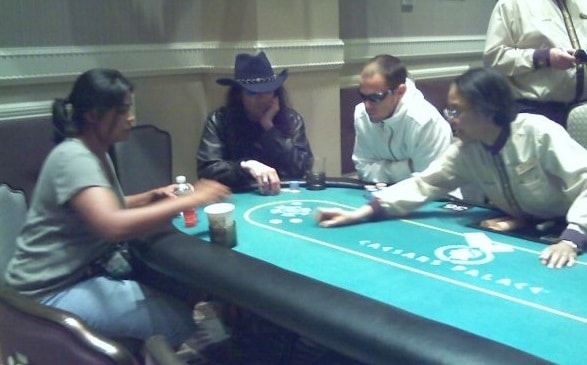When we left our tournament in my last article, the bubble had just burst and you had cashed. Congratulations! But this is no time to rest on your laurels. In fact, one can argue that the real battle to realize tournament equity begins once you’re ITM (in the money).
Before exploring that battle in detail, there’s an interesting quirk to tournaments of this type and field size. Frequently the bubble will burst when there are twelve to fifteen players remaining. Despite the fact that pay-outs typically are fairly flat for the next few bust-outs, I’ve noticed that many players approach this stage as if there was another meaningful bubble at the final table. In other words, they enter few pots and seem to be waiting to “ladder up,” even though the ladder is currently resting horizontally on the ground.

I can think of two explanations for this. The first is simply that such individuals have become too immersed in poker narratives, and enjoy reporting back to their friends that they “made the final table.” A second possibility is that they recognize they play poorly short-handed (or simply dislike doing so), and are waiting to be returned to their full-table comfort zone. And, yes, I agree it is counter-productive to play tournaments if you dislike short-handed play, given that so much equity is locked up in doing so well, but equally I have heard tournament players admit to this very weakness.
So how does this benefit us? Bubbles, even if they are only perceived ones, favor the aggressive, so if you get the sense that players are going turtle, punish them in the normal way. Further, when the tournament does combine down to a single table, most of your current opponents will join you there. Consequently, this is a great opportunity to assess how well each villain handles short-handed play; important information because your goal is to be involved when the situation is mirrored at the final table.
The Final Table
When the smiling tournament director appears shuffling seat cards and congratulating the remaining players, I like to do a mental reboot. There’s usually a couple of minutes pause before the action resumes, so I use this time to take a brief walk. Then I do something important to which the majority of players at this level seem completely oblivious.
Stack distribution. Unless the final table contains a couple of world-class players (it won’t) and a handful of people who have never studied the game at all (it might), the most important determining factor in how you attack the final table is the distribution of stacks. Specifically, where are the big and small stacks relative to your position at the table? This becomes slightly less important if you’re fortunate enough to be chip leader, but with an average stack it is absolutely critical.
In a perfect world, you want short stacks on your left and big stacks on your right. Laddering up is now genuinely important, so with short stack on your left you can exert a lot of pressure by attacking their blinds. Similarly, you prefer to see what the large stacks are doing before you have to act, since they can bust you. Depending on specific stack depth, you’re typically happy to have an active big stack to your right, since you can attack their raises with all-in 3-bet shoves.
So what if the stack distribution is back to front, with shorties to the right of you and the chip leaders to the left? You’re going to have to tighten up a bit. Again, in detail the precise stack depths matter. A common situation is that the shorties will be in push-fold mode (less than about 13bb), the average stacks will be ideal for 3-bet shoving (around 13-25bb), and one or two players may be deeper than that. If you have an average stack, shorties shoving all-in before you take away your fold equity. Similarly, if you open, large stacks to your left can shove over the top of you, again denying you the opportunity of making that crucial all-in bet.
The important point to recognize in all this is that these shallow-stacked situations have been analyzed to death, and there is a wealth of readily-accessible information on how to play them to the point that there’s no reason for you to ever make a mistake. In addition to many videos in our PRO library, my personal recommendation is to spend some time experimenting with a tool like the HoldemResources calculator (HRC). Among it’s many useful features, this allows you to include explicitly the effect of the pay-out structure; that is, it provides a simple method of moving from chip EV to cash EV.
I indicated above that the push-fold regime is roughly for stacks below about 13bb whereas the 3-bet shove range begins there and moves up to about 25bb. There are a lot of rules of thumb that one can employ in these spots, such as 3-bet shoving with a stack up to 10x the open, although honestly dedicated work with HRC will serve you much better in the long run than relying on simple short-cuts.
I’ll repeat this point because it is so central: how you play ITM will determine your long-term tournament ROI. And while it’s true that this stage of a tournament is in some sense “solved,” it is also critical that you pay attention. I get the impression that many of my opponents are so delighted to have cashed, they pretty much go into cruise control as they announce their success on Twitter. The point to appreciate here is that while the mathematics of short-stacked play have been established, most of the table will not have studied the topic in any depth. Added to this, your opponents will often make life easy for you through bet-sizing tells and other information seepage.

One common tell I see is players who will min-raise from LP with a hand they are planning on raise-folding to a shove, while opening 3-4x with a hand that they deem good enough to get all-in preflop. Candy thief, meet baby. What seems to have happened post-Harrington is that players have absorbed the idea that they should be attempting to steal the blinds at this stage of a tournament, but they’ve never looked at their ranges in a methodical manner. In my experience this means their number of raise-fold combos are way too high relative to their raise-call combos to the point they are auto-exploitable. If this tendency is combined with the aforementioned bet-sizing tell, you’re going to enjoy the final table.
I view the above ideas and guidelines as starting points for further study for the serious tournament student. There are many details beyond the scope of this introductory series, but it is important for you to appreciate how much you can accomplish in this area. You really should be able to get to the point where you play close to error-free poker in these shallow-stacked situations, and given that the majority of your opponents will be making plenty of mistakes, the net result is hugely profitable.
The Deal
We now get to the part of tournaments which I like least. The deal. Since moving to Vegas seven years ago I can recall only one situation where I reached a final table and some kind of chop wasn’t agreed. I suspect the main reason I’m not fond of them is that I am not particularly assertive. I’d probably be better off if every tournament I played just played out, particularly since a background in online sit-n-goes means I have considerable short-handed experience. But if you’re someone who enjoys haggling at the dealership over the price of an automobile, this is an opportunity to shine and profit.
My first suggestion is never be the one to start discussion about a deal. This is natural in my case since I don’t want one, but even if you’re at the point where you figure a deal is to your advantage, opening negotiations has some pitfalls. Most notably, by broaching the topic I feel you immediately put yourself in a weak negotiating position. You’ve announced that you’d prefer to terminate play, and your more self-confident opponents will seize on that. Whether they interpret your deal proposition as being indicative of tiredness, short-handed discomfort, or something else entirely doesn’t really matter. All they have to do is claim they’d prefer to keep playing, but suggest they’ll quit if you give them a good cut, and you’re rather on the back foot.
By letting someone else bring up the topic and remaining quiet, you can get a far better read on where your opponents are psychologically. Anyone who seems overly keen to wrap up proceedings is probably going to settle for a chop in which they get less than their ICM equity. Additionally, by not saying anything you give someone else the opportunity to nix the suggestion. If your goal is to continue playing, this is extremely useful for a somewhat unpleasant reason which again relates to my dislike of deals.
Players in Vegas really like chopping. If you’re the one throwing a wrench in the works, they will be displeased with you. And while I’m well past the age at which a stranger’s opinion of me matters in the slightest, the reality is that by adopting the role of chop blocker you put a target on your back.
Say you’re five handed and your four opponents are all enthusiastic to chop it up. When you decline, you have just made life more difficult for yourself. Even if the other players are upstanding citizens who would never consider any form of collusion, they’re going to do it anyway as a result of the asymmetry your decision has created. They will likely play against you differently than they play against each other. This collusion may be tacit and subtle, but I can think of no situation in which four players who want the tournament over are going to adjust their decisions in a way that is anything other than detrimental to your chances of realizing your equity.
To avoid these situations and the nastiness that sometimes ensues, I now have two related ways of handling the chop. If I am short-stacked and I know the room has the facility to calculate a true ICM chop, I will accept that. This is invariably preferable than letting players use their own peculiar algorithms for what is fair. If I am the big stack or close to it, my approach is to explain I’d rather play on, but will agree to a chop provided I get $X. The point here is that an ICM chop typically gives the chip leader less than many players expect – their funny algorithms invariably assign too much equity to big stacks – so in such spots I tend to be more pro-active in throwing out a number I’ll accept. I’d recommend you look at some ICM chops, again using a tool like HRC, so you have a feel for how these numbers work.
One final bit of advice. Depending on the buy-in, you’ve now got a fair chunk of cash on you. In many casinos, the fact you have just been handed a significant sum is easily deduced by people who may not have your best interests at heart. Be smart about how you get that money home.
To read the final installment in this series, please click here.


If you feel at all uncomfortable walking around with a lot of money you can ask for a security escort or even just leave the money there and come back later. I have heard you can ask for a check but I have always just come back the next day and taken the money directly to the bank.